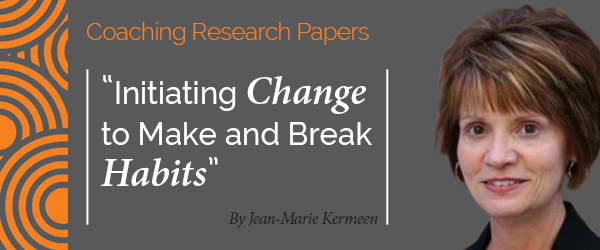 Research Paper By Jean-Marie Kermeen
Research Paper By Jean-Marie Kermeen
(Executive Coach, UNITED STATES)
Our dilemma is that we hate change and love it at the same time; what we really want is for things to remain the same but get better. Sydney Harris
Introduction
The International Coach Federation website describes the coach’s role as
…help[ing] clients produce fulfilling results in their personal and professional lives. Ultimately, coaches help people improve their performances and enhance the quality of their lives.
In The Sherpa Guide: Process-Driven Executive Coaching it states that
…executive coaching…is designed to produce specific, positive changes in business behavior within a fixed time frame (Corbett & Colemon, 2006).
Coaching is centered on helping clients achieve their goals, which may include various types of change: a change in approach, a change of behavior, or a change in perspective that can allow them to reach their goals. Every person responds to change in their own unique way. Some embrace it while others may resist. Because people are creatures of habit, creating lasting change can be very challenging. Through this paper the reader will have a clearer idea of what a habit is and the how the change process can help make or break a habit.
Self Actualization
Abraham Maslow, the founder of humanistic psychology, developed the hierarchy of needs. At the top of the pyramid, and the topic he was most interested in, was
self-actualization, the process of developing one’s potential and becoming the best person possible (Coon, 2006).
Working towards realization of this goal of “developing one’s potential” indicates a need to initiate some kind of change.
The “Three Brains” and Habits
In her book, This Year I Will…, M. J. Ryan provides information from neurologist Paul MacLean on brain development relating:
…Inside our head are three brains, not one. Each corresponds to a different stage of evolution, and while they are connected to one another, each acts independently and is often at odds with the others (Ryan, 2006).
The “reptilian brain” controls the involuntary actions (heartbeat, breathing, etc.) which keep the body alive, while our limbic system or “emotional brain” is where our feelings and instincts are focused. Our emotional brain “propels us toward pleasure and away from pain.” The third brain is our “thinking brain” and this is where reasoning and logic take place (Ryan, 2006). This “three different brains” scenario is demonstrated very well in commercials aired by the Minnesota smoking cessation organization, QuitPlan.
These commercials show three sides of one person: the emotional, logical, and physical sides arguing amongst themselves to demonstrate just how difficult it is to get all three parts of a person to agree to quit smoking. In a similar way this same scenario is played out when trying to break or establish habits.